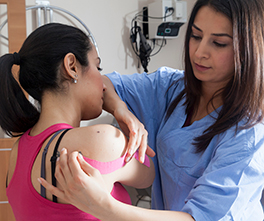Speech therapy is often part of the treatment for many conditions, including brain injuries. Patients in Fairfield County can now receive outpatient speech therapy at Hartford HealthCare’s Rehabilitation Network location in Stratford.

Speech-language pathologists (SLPs) evaluate and treat all aspects of people’s communication skills (comprehension, speaking, reading, writing, conversational skills, non-verbal communication) as well as cognitive-communication skills that can impair a person’s ability to communicate effectively (attention, memory, organization, reasoning, judgment).
“We often see patients who have had an injury or have been diagnosed with conditions that affect their speech, language, voice, cognition or swallowing,” said Sarah Gromko, a speech-language pathologist now seeing patients at Hartford HealthCare’s Rehabilitation Network in Stratford.
Some reasons patients may seek speech therapy:
- Stroke.
- Traumatic brain injuries.
- Parkinson’s Disease.
- Voice injuries.
- Changes in voice that happen due to aging.
- Dementia.
- Long-haul COVID.
- GERD.
- Chronic cough.
- Head and neck cancer.
- Gender-affirmation of voice and communication.
By using state-of-the-art equipment and evidence-based treatment approaches, SLPs can maximize brain repair and improve outcomes.
“Our focus is to help patients overcome or compensate for difficulties to achieve their highest level of function, independence, safety and quality of life,” Gromko said.
Early intervention is crucial following a neurological injury or with the onset of a progressive condition. Length of treatment depends on the patient and severity of the disorder.
“The speech-language pathology field is constantly evolving as new treatments and instruments develop,” Gromko said. “One of these is a two-part therapy program designed to help patients with Parkinson’s Disease regain and maintain effective communication. It converts speech from an automatic function to an intentional act, to enhance vocal loudness and clarity. We also have instrumental tools to measure changes in respiratory pressure and voice quality that patients can see and control with visual feedback.”


